Pad Kra Pao (Holy Basil Stir Fry)
Ever since learning about this dish a few years ago, I had been ordering it by default at Thai restaurants. While in Thailand on this trip, we had also eaten it from the very first lunch in centralwOrld to the very last dinner in Chiang Rai Night Bazaar. This comfort food item was not only a convenient go-to when we didn’t know what else to get, but also a great benchmark to judge the quality of a restaurant.
Thus I was excited to finally visit Ung Jia Huad, an uncle famous for his pad kra pao, after having his address in my notebook for 4 years. Note that the bar had been set very high for him – not only had I read and watched Mark Wiens raving about him, I had eaten more versions of this dish than any other Thai food. And he did not disappoint… his food was in a league of its own.
Having a roof was about all that you could say about his eatery at the street corner. It was dark. It was old. The menu was short. Even though he cooked using a wok on the sidewalk, the chili-infused smoke filled the dining space. Everyone from us tourists to the shop workers was teary and coughing… not a great sign for a pleasant meal! And yet when the food got put on the table, we could taste the wok hei in addition to the addicting flavors and the perfectly crispy-and-runny fried egg. We got one plate with minced pork to start, plus a plate of pad see ew (not pictured but also the most amazing pad see ew ever). Before finishing that round, we asked for another pad kra pao with pork and one more with chicken. The lady seemed a bit skeptical when I requested the last plate to be regular spicy (vs. “very little”). I managed, probably because I already had food in the belly, and it was great.
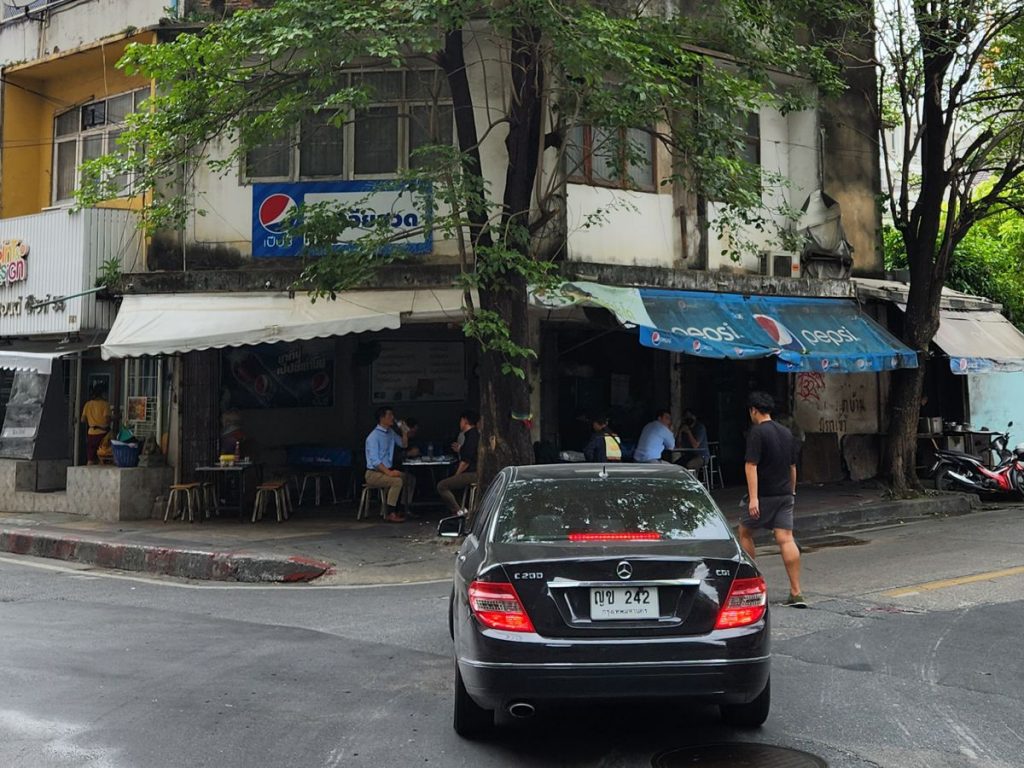
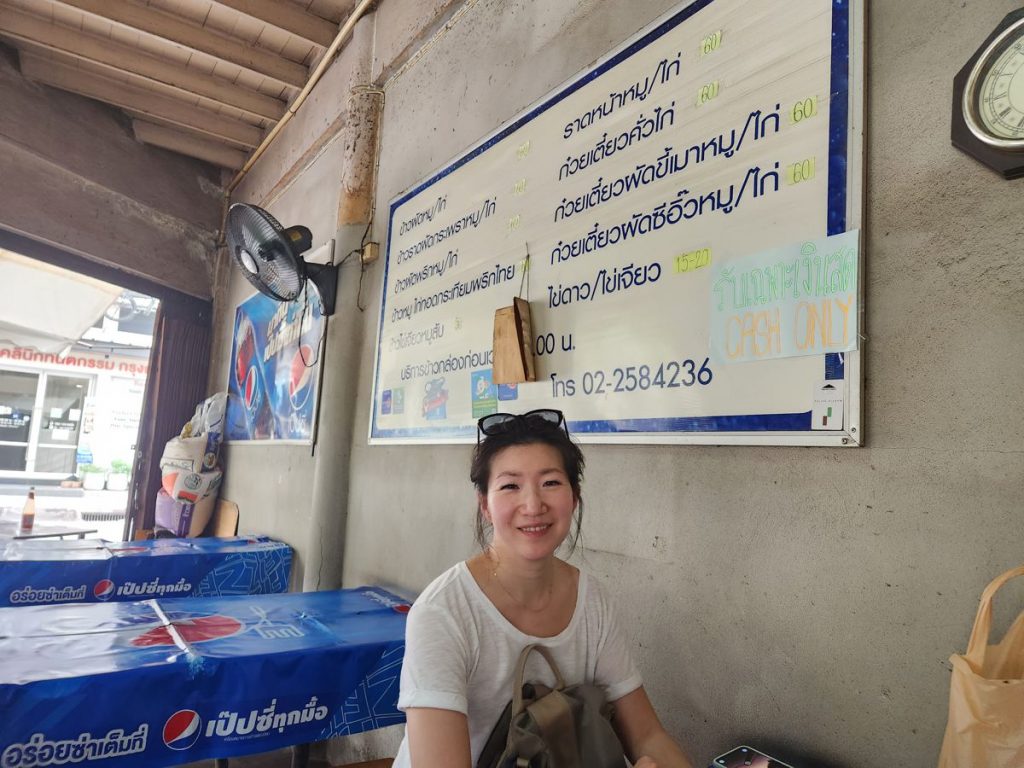
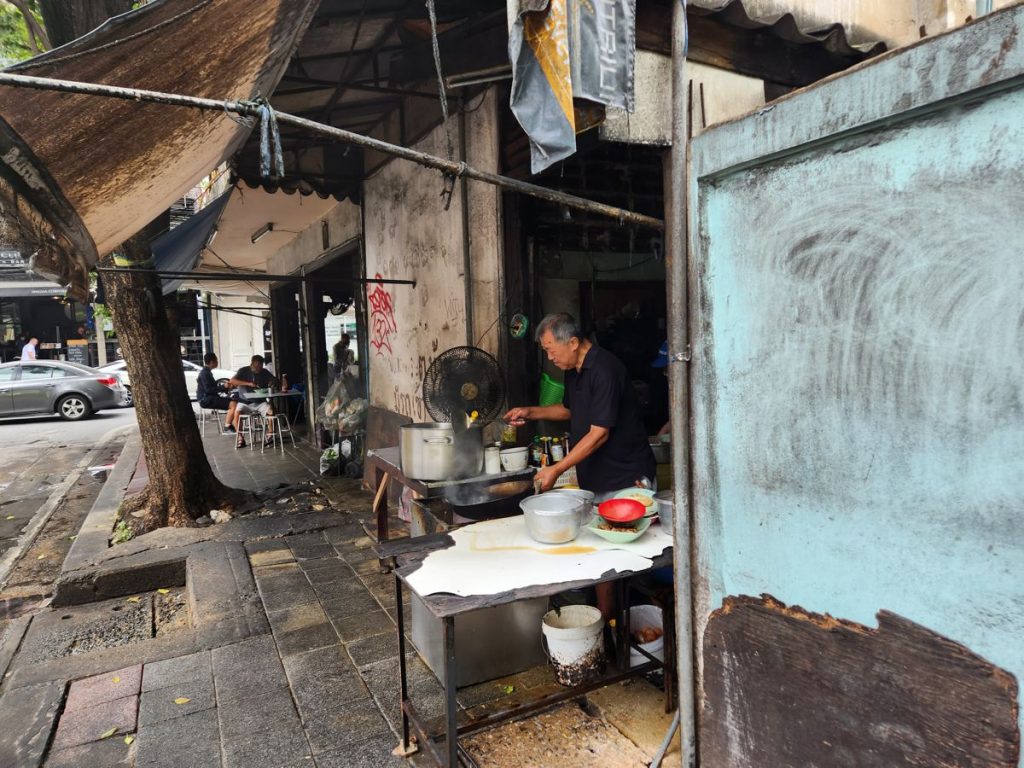
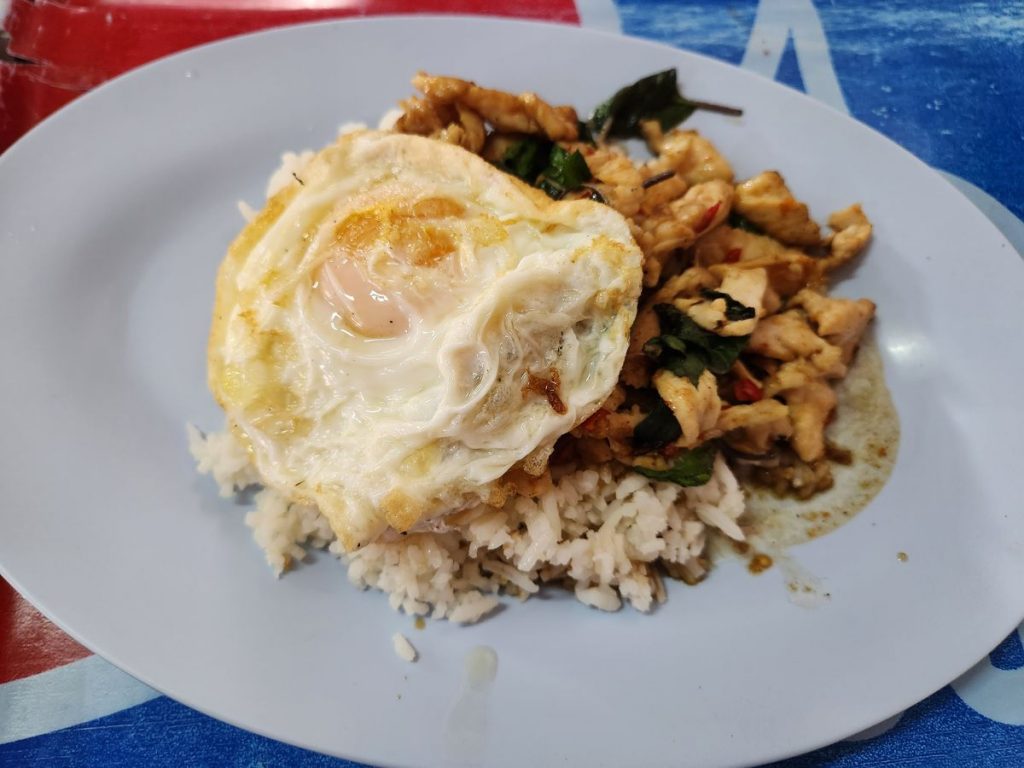
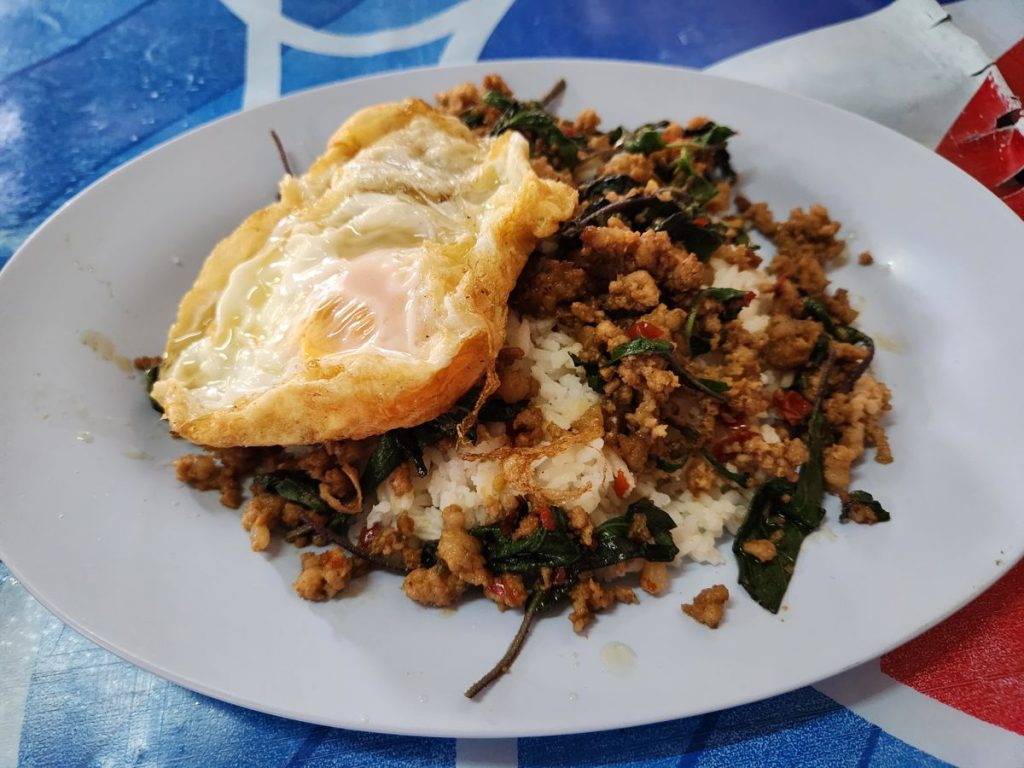
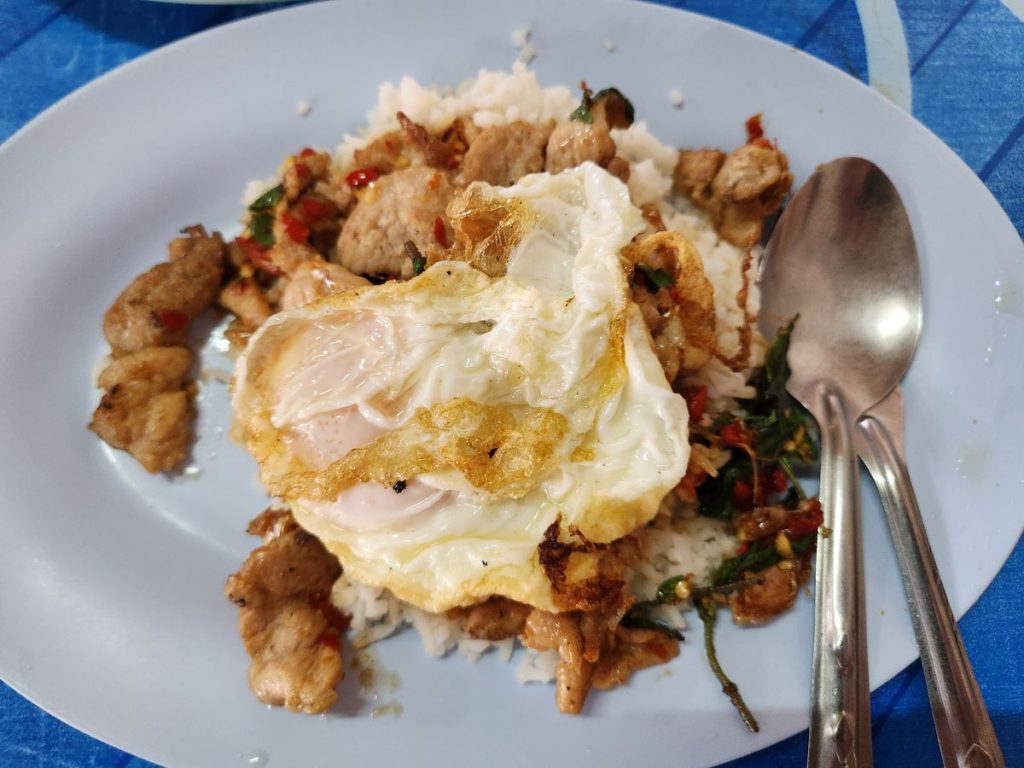
Kuay Teow Ruea (Boat Noodles)
Hong and I have a special love for boat noodles because we “discovered” it ourselves five years ago. Sure, it’s among Bangkok’s most famous street foods, but somehow we never came across it before that trip. On that fateful day when we had to dodge a sudden thunderstorm while in Wang Lang, we stumbled upon this noodle shop and fell in love.
Of course, we had to pay respect to that same shop again. We were pleased to know that our kids were onboard after the first sip, too.
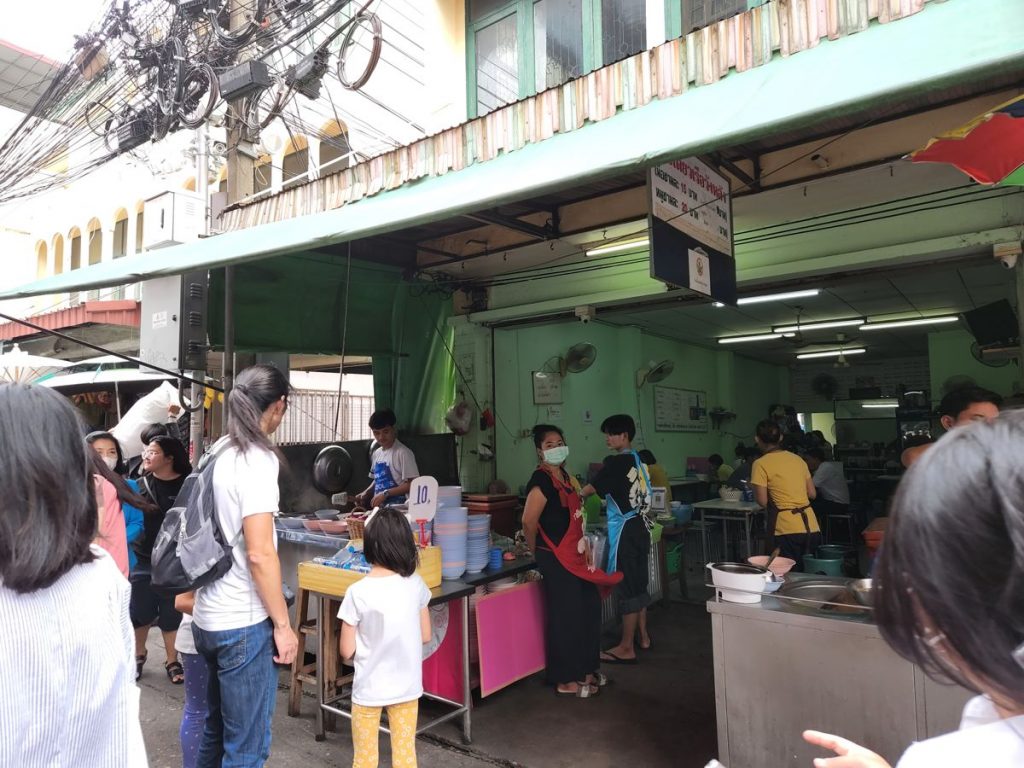
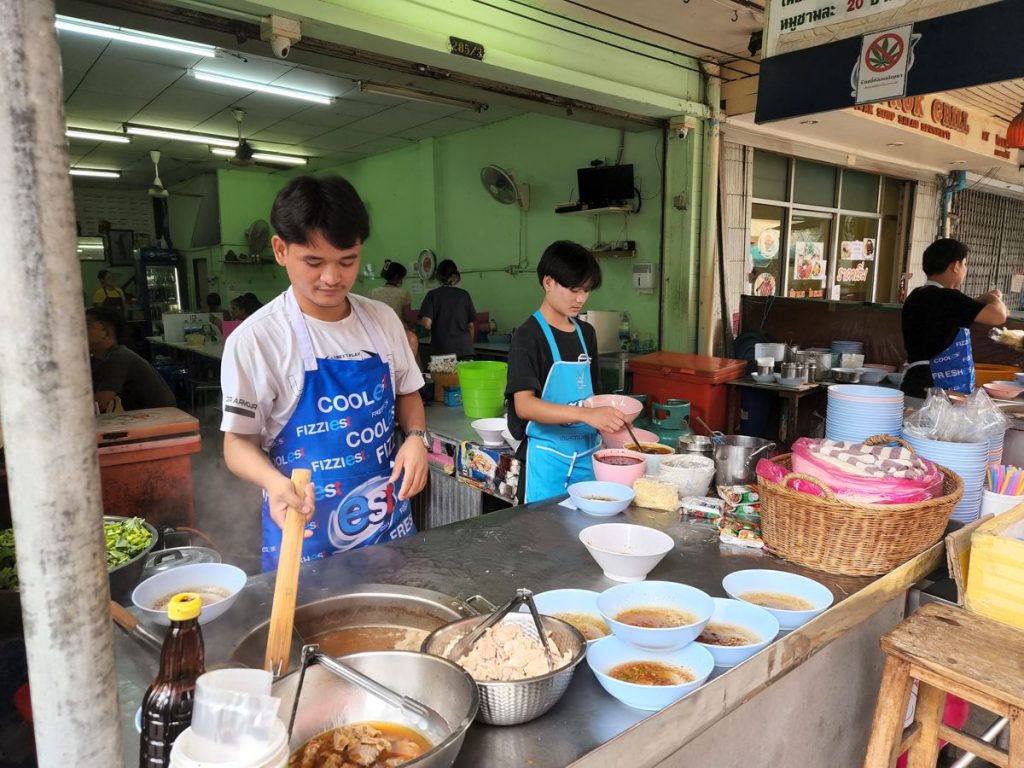
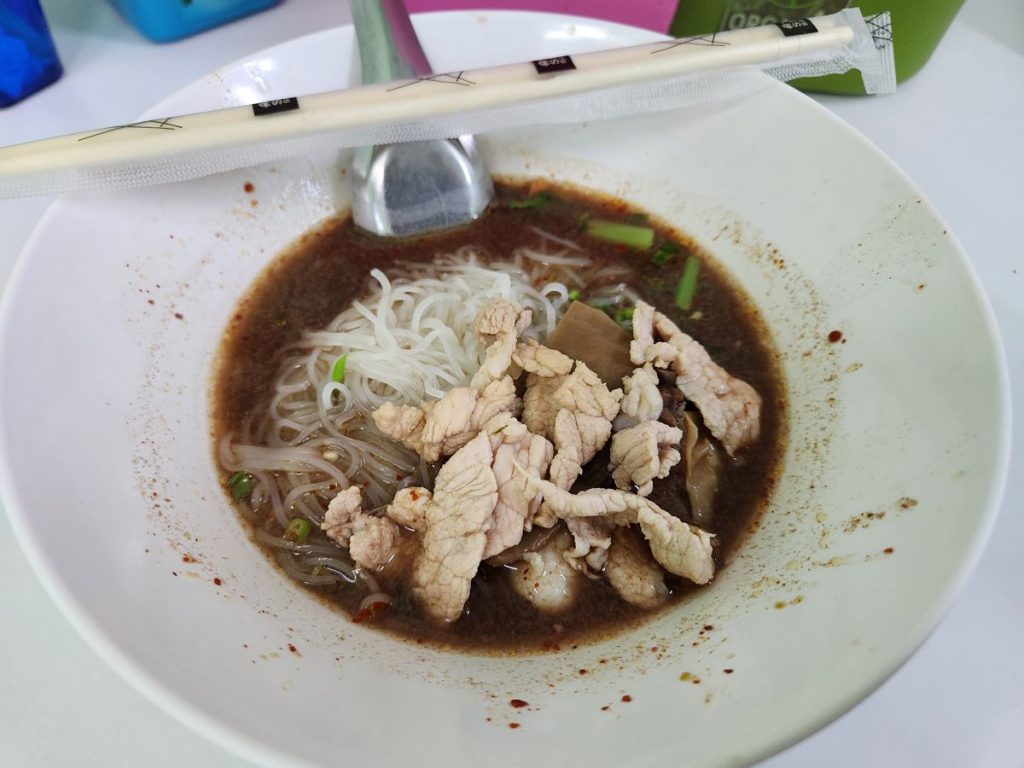
Then we went a couple doors down to a more general-purpose restaurant. Among other things, we tried a bowl of boat noodles. It wasn’t nearly as good, but it was good to know that people made this dish in lighter, more soupy variant.
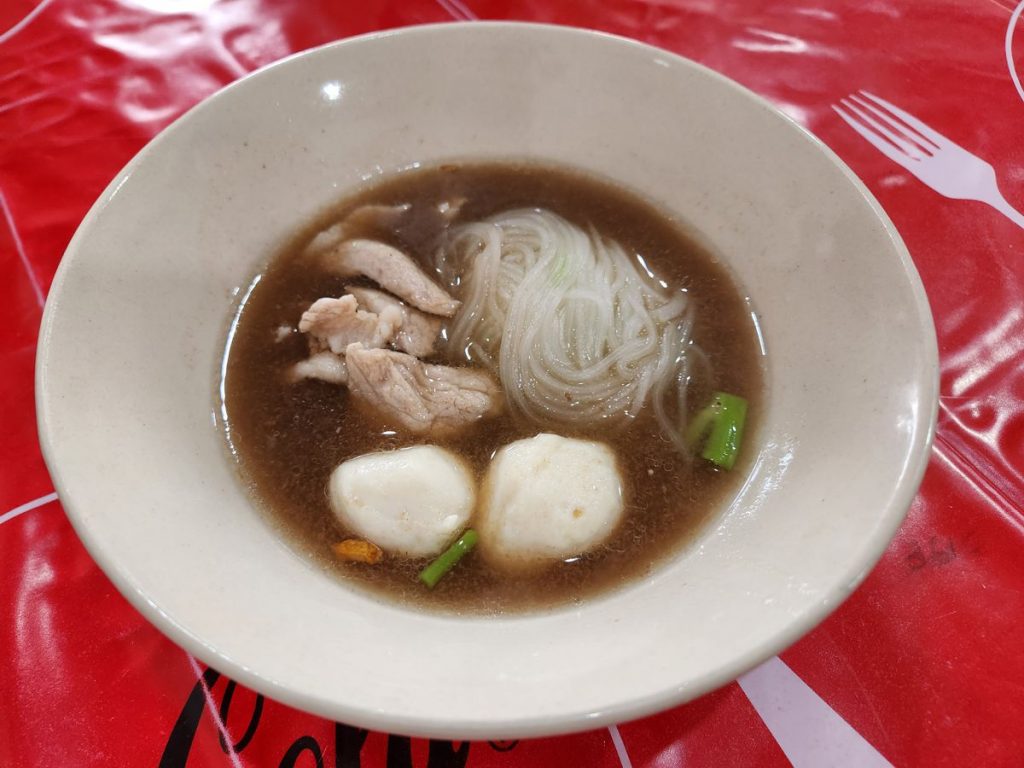
Then we visited the Boat Noodle Alley at Victory Monument. The shop on the right at the end of the bridge (Pa Yak) was preferred by Hong and Xuan for its rich and non-spicy soup.
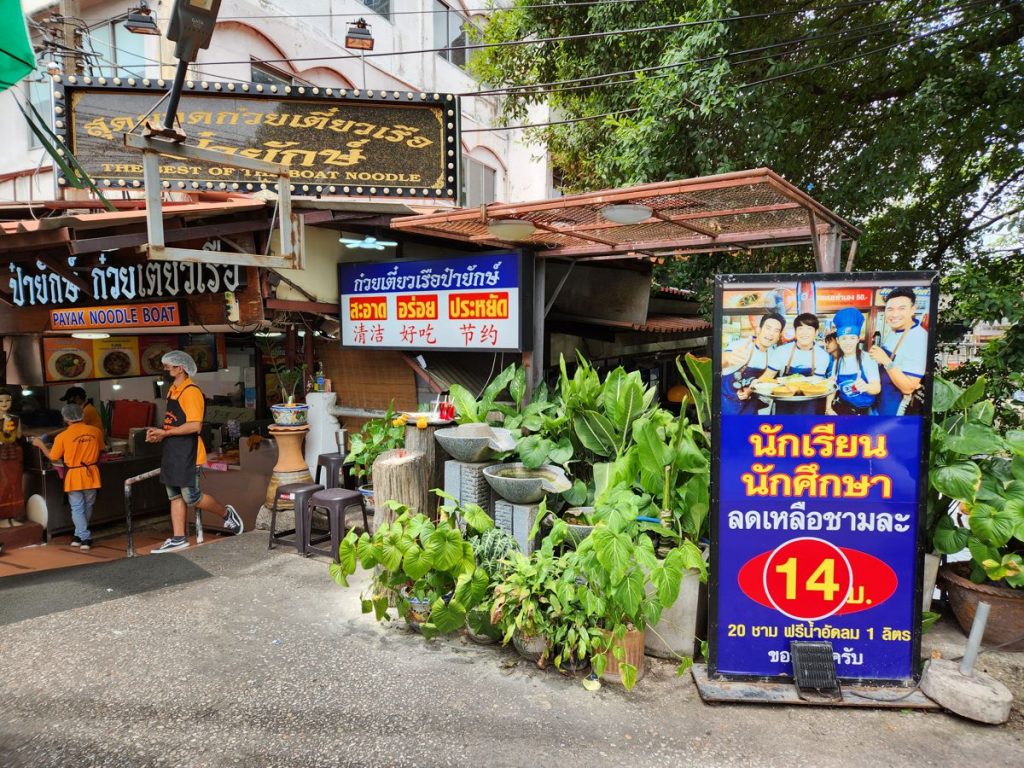
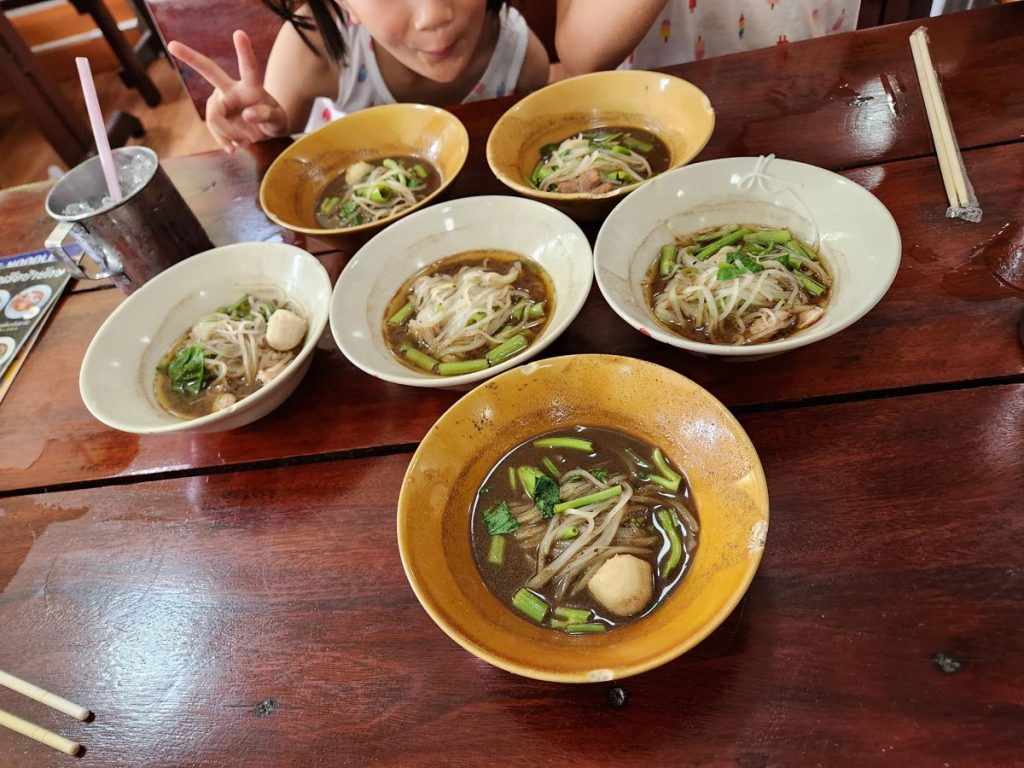
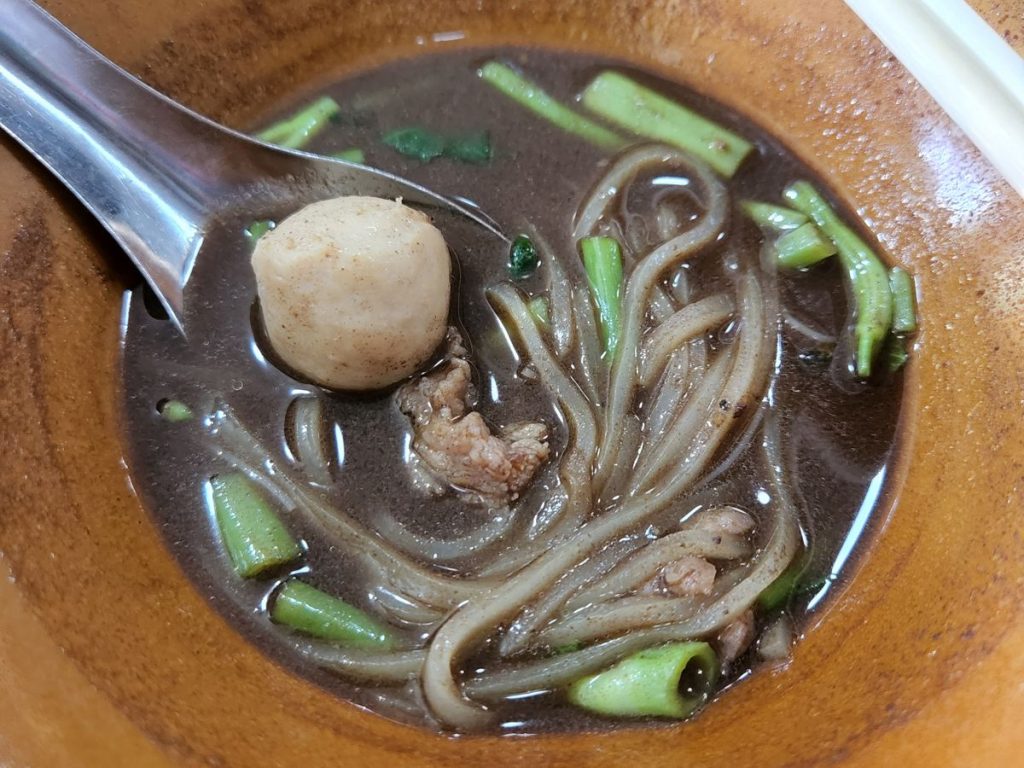
The one directly across (Baan Kuay Tiew Ruathong) had spicy soup by default. While I liked the flavor, I would’ve preferred customizing it myself with condiments. Curious that this restaurant had a longer line out the door, though.
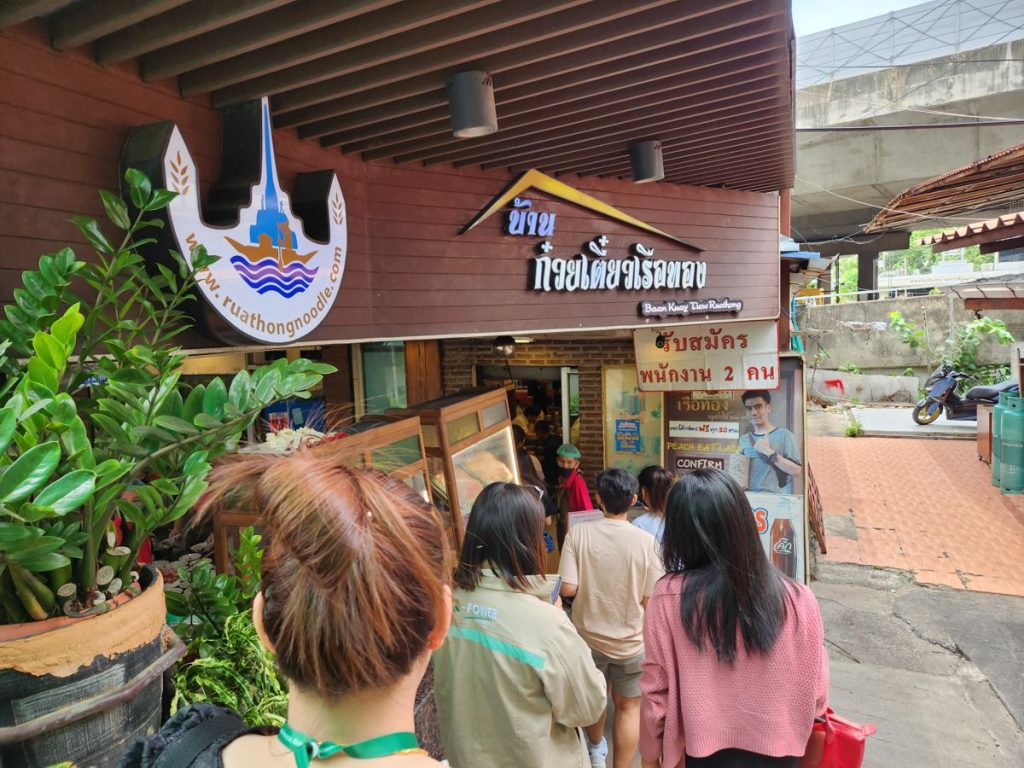
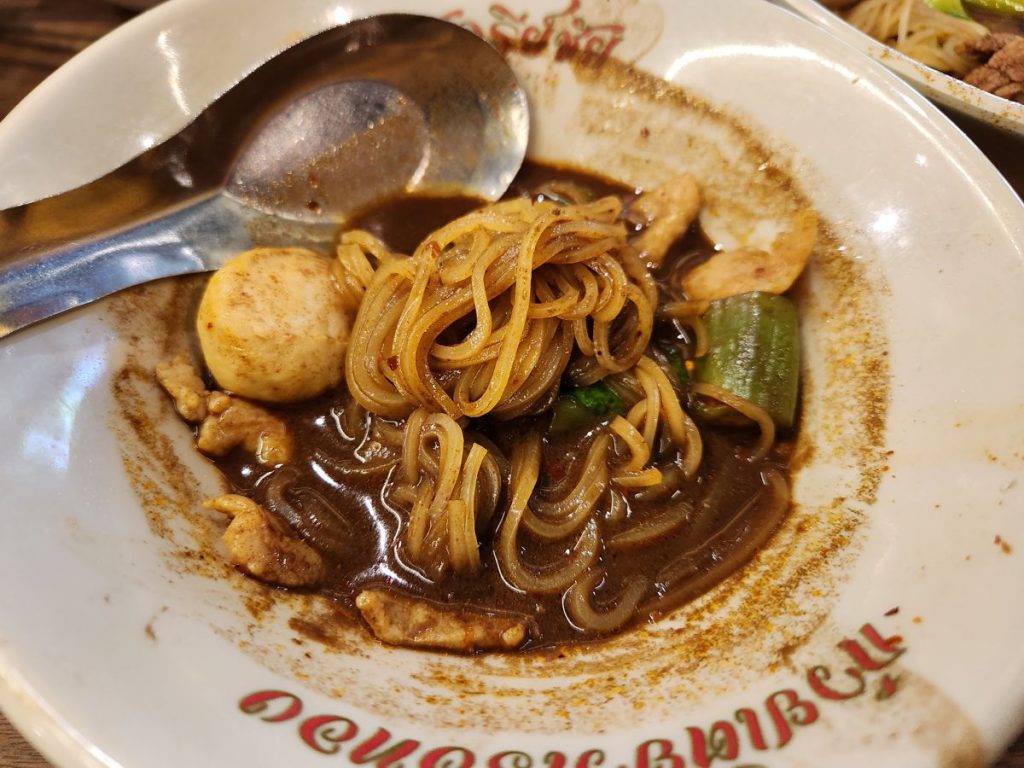
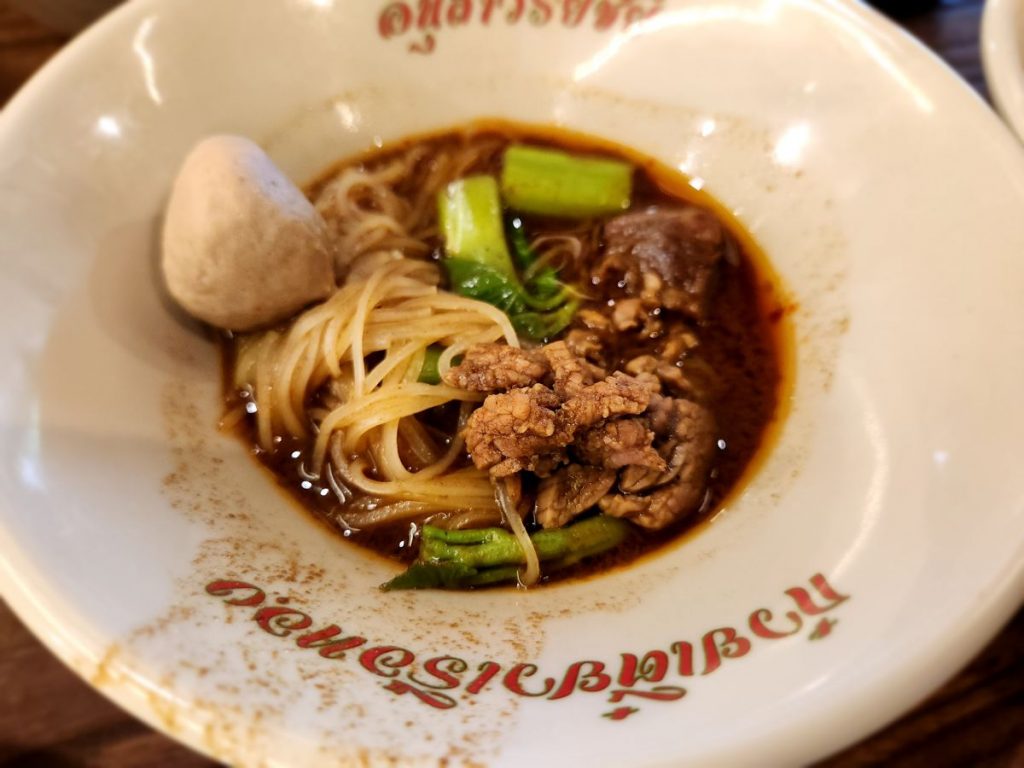
At the end of the day, my favorite was still that shop in Wang Lang, with no English on the menu and no tourist (aside from us?) among its customers.
Khao Soi
The boat noodles’ counterpart in Northern Thailand was Khao Soi, a spicy and creamy coconut milk curry noodle soup. It was kind of like Malaysia’s Laksa but without the seafood. It seemed to always come with pickled mustard, raw onion, and a wedge of lime.
To maximize our first impression of this dish, we noted down 4 of 5 restaurants that contended for having Chiang Mai’s best Khao Soi. We ended up only having time to try two, but also ate this dish at a few other restaurants. Pictures below were from Khao Soi Khun Yai, Khao Soi Islam, and a random restaurant with a full English menu and all sorts of dishes.
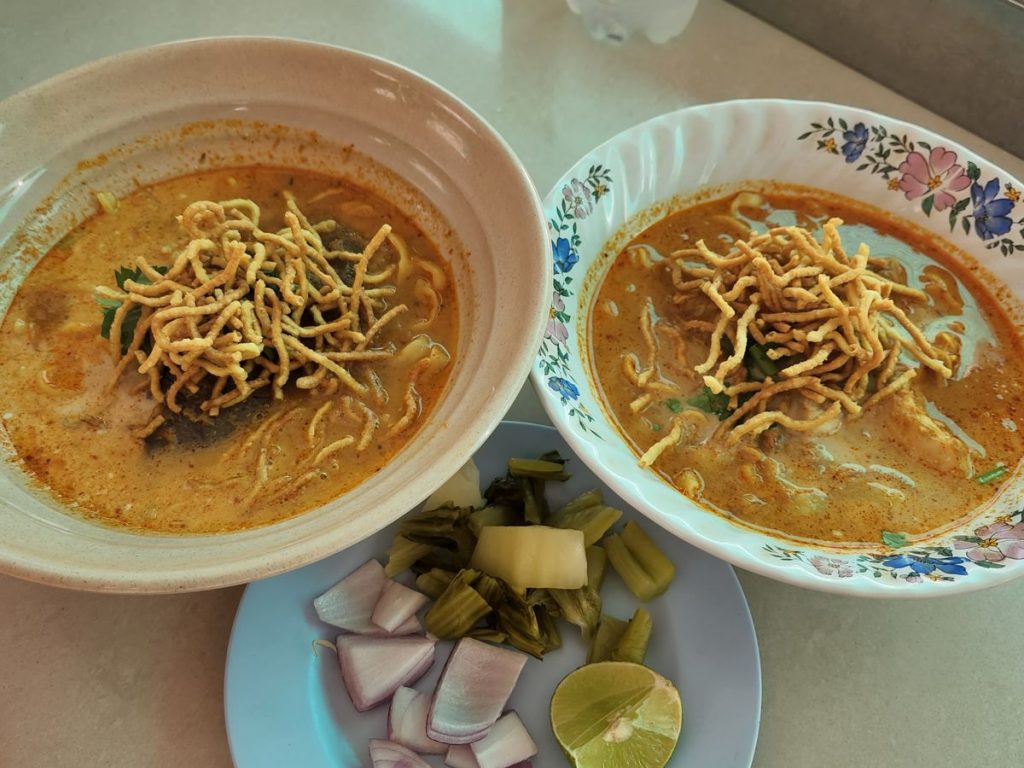
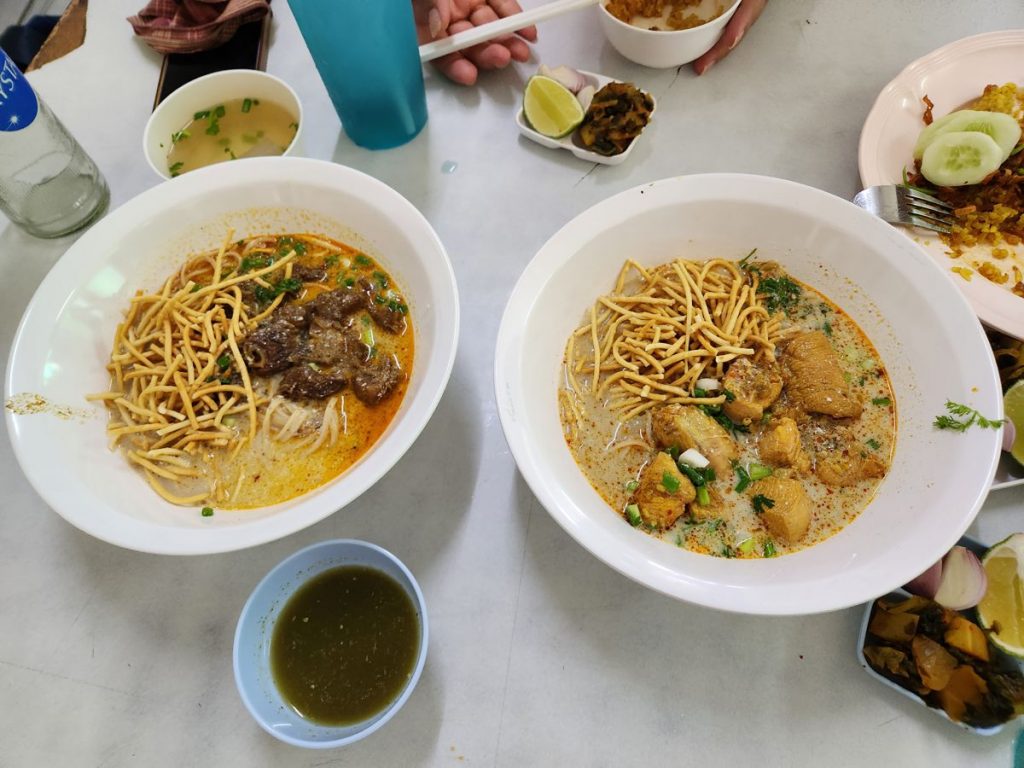
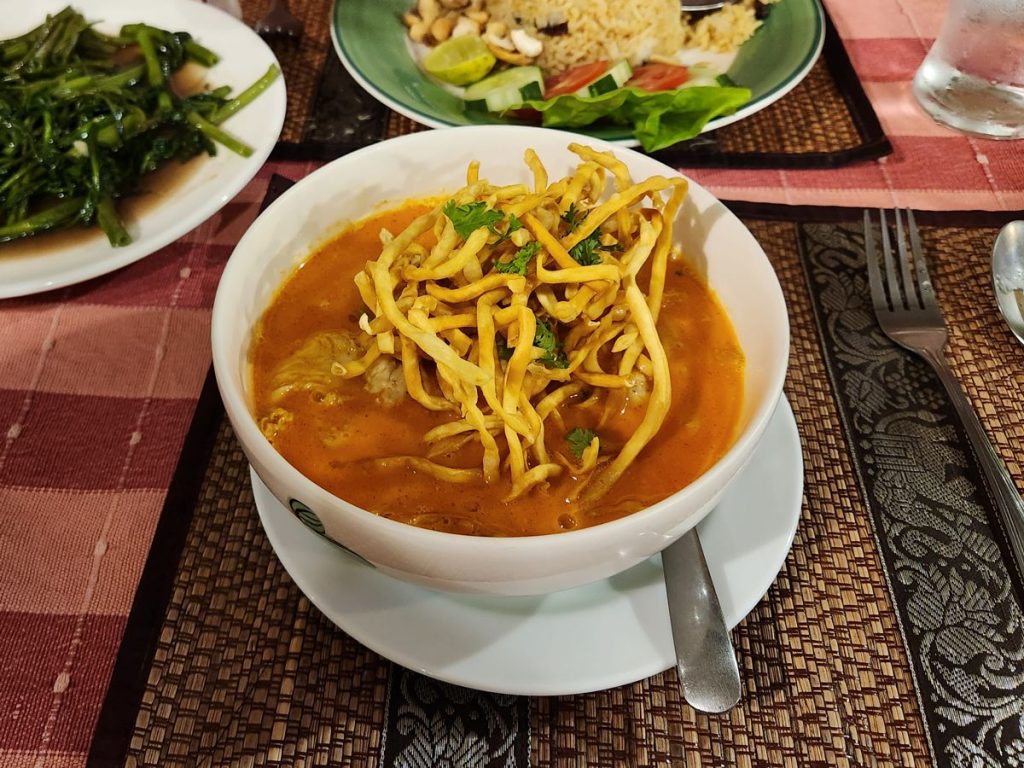
Of the three, Khao Soi Khun Yai had the most chewy noodles, which was important to us. Soup was harder to tell apart though I may prefer Khao Soi Islam a bit more. We enjoyed this dish a lot, but it would be so much better to eat it on a cold day.
Khao Man Gai (Hainanese Chicken Rice)
Chicken rice in Thailand was somewhat less famous than chicken rice in Singapore, but it was equally good. Like the boat noodles in Victory Monument, there were (at least) two competing chicken rice joints in Pratunam where workers wore distinctively different colored shirts. And of course we had to try both.
Then I was confused about how exactly these two could be considered going head to head. Go-Ang, the pink one, was far superior in every way… tastier rice, juicier chicken, more space, and cleaner. Kuang Heng, the green one, was hardly something we’d care to eat again. Perhaps it’s cool that Kuang Heng had a fried chicken version of the dish? Actually, no, we didn’t like that, either.
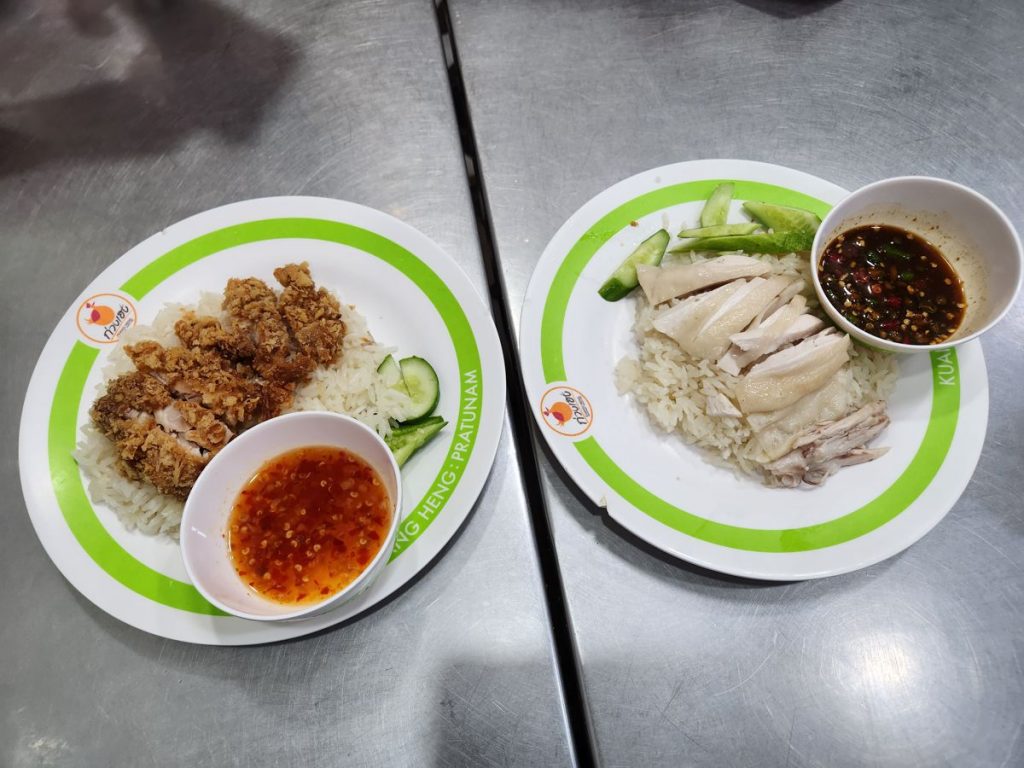
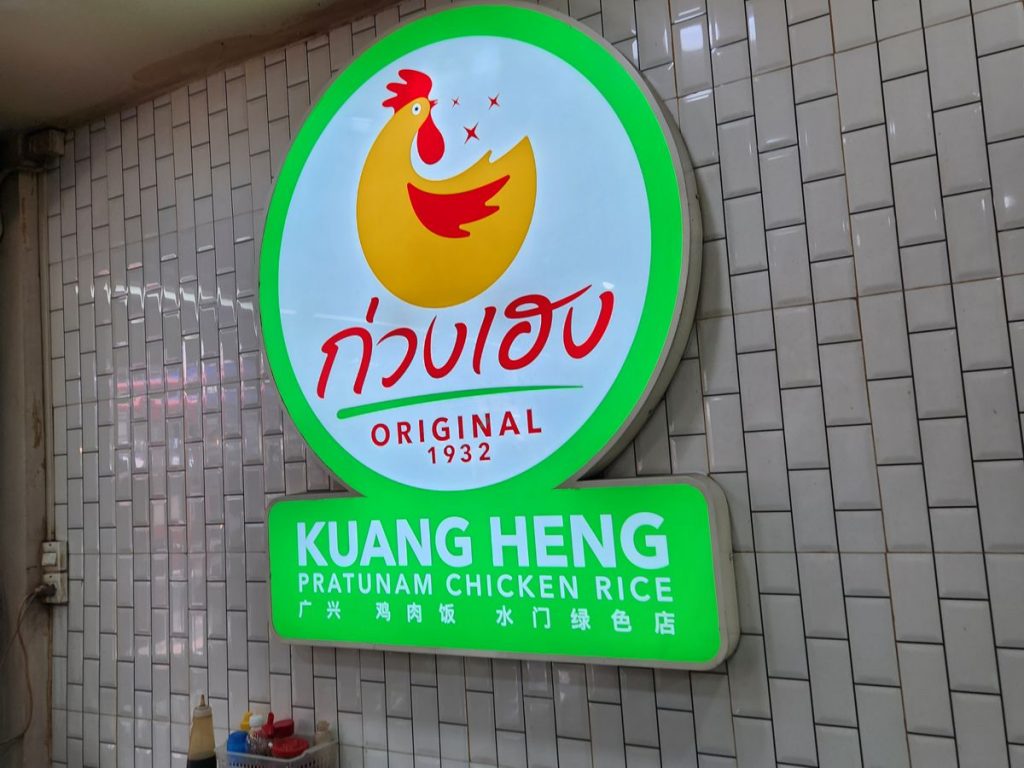
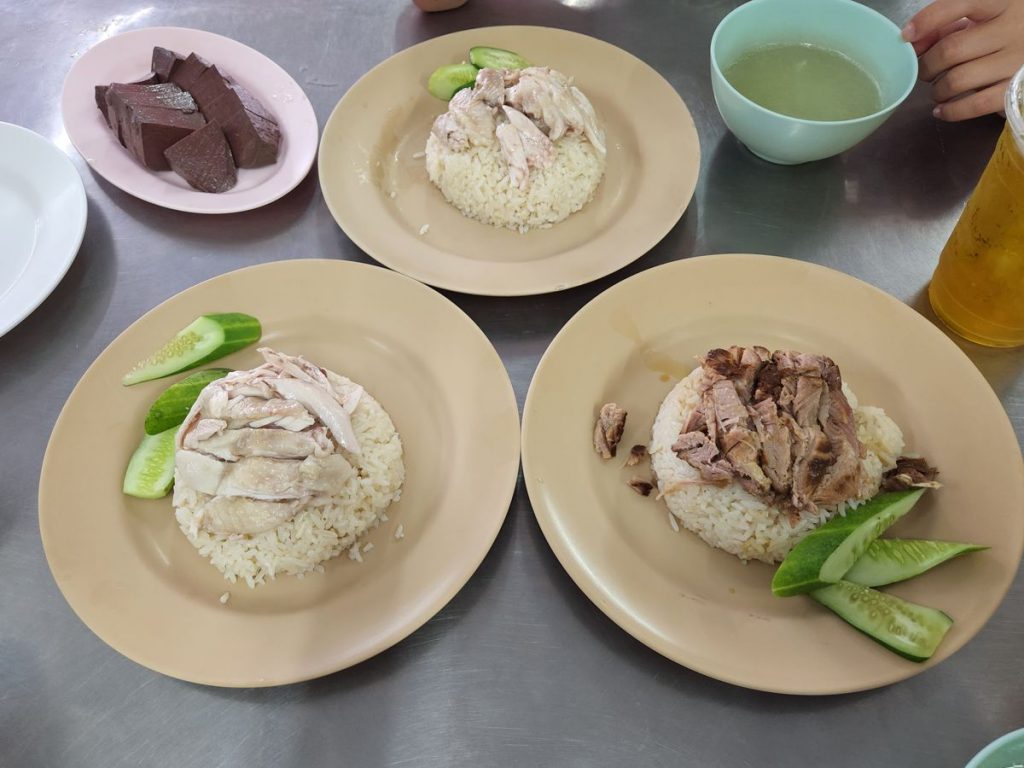
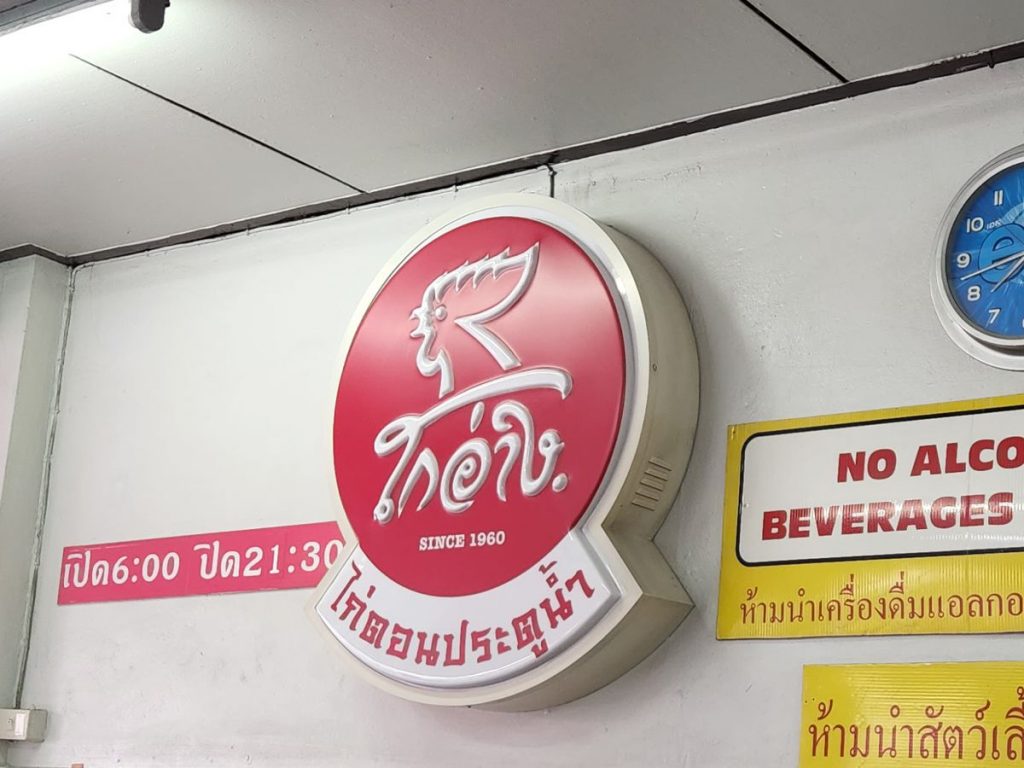
Go-Ang sold chicken blood jelly as a side, and I loved it.
Khao Mok Phea (Goat Biriyani)
Khao Soi Islam had a longer menu than the standard noodle shop, and was also famous for its goat biriyani. I’m not sure why Khao Mok was translated to biriyani because, at least compared to the Indian biriyan, this dish looked more like a Nasi Lemak with stewed meat and raw cucumbers over plain rice. It was delicious and we ordered a second plate during the same meal.
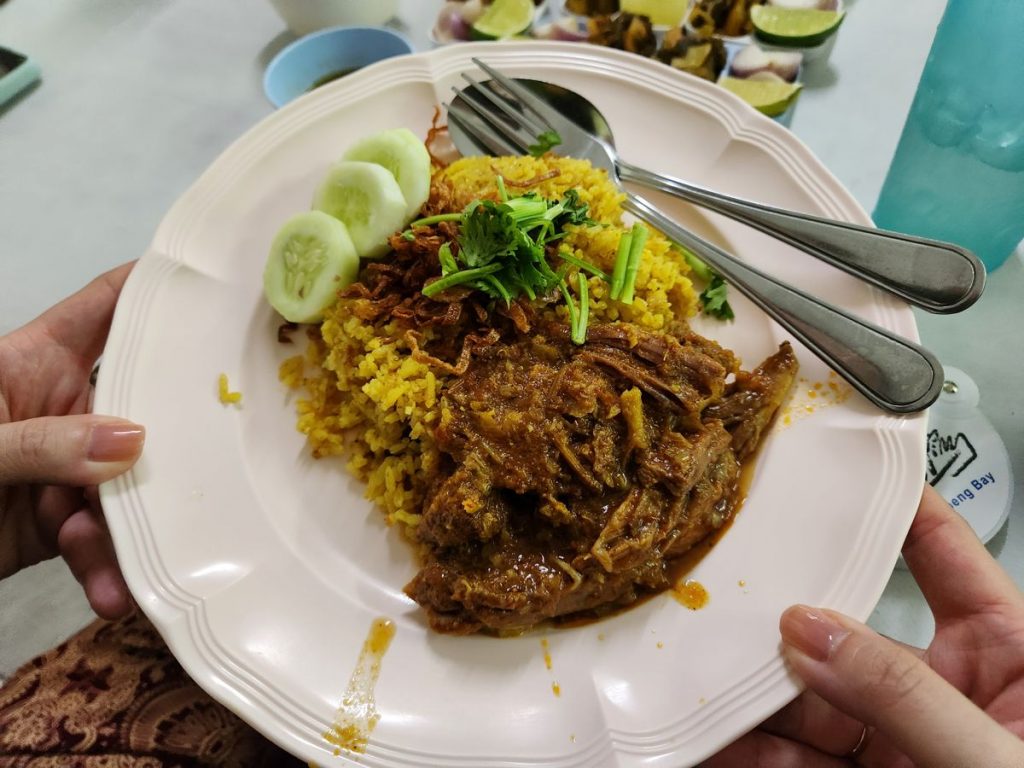
Leng Saeb (“Volcanic Ribs”)
Since Mark Wiens posted about it a few years ago, we had regularly seen people on the Internet raving about “Volcanic Ribs” in Bangkok’s night markets. It looked awesome, but mostly because of the sheer quantity Youtubers ordered for spectacle. While I was interested, I had no intention to order a whole mountain of this stuff.
It turned out that smaller orders were available, and the girls were quick to agree on sharing a plate with me. We discovered that “Volcanic Ribs” were not ribs at all, but pork spine. I’m guessing the translation was for the convenience of Americans whose idea of edible meat-on-bone was exclusive to ribs. Hot Thai Kitchen has a post explaining the origins of this dish.
The dish came with disposable plastic gloves. They weren’t great. All of us ended up with a leakage problem, where the oil got in, coated the entire interior of the gloves, and made our hands greasier than they would have otherwise been. I was disappointed by it being both cold and non-spicy, the opposite of what I thought “volcanic” meant. There was also far less meat than anticipated because it was spine and not ribs. But it was still a fun and tasty experience that we were glad to have had.
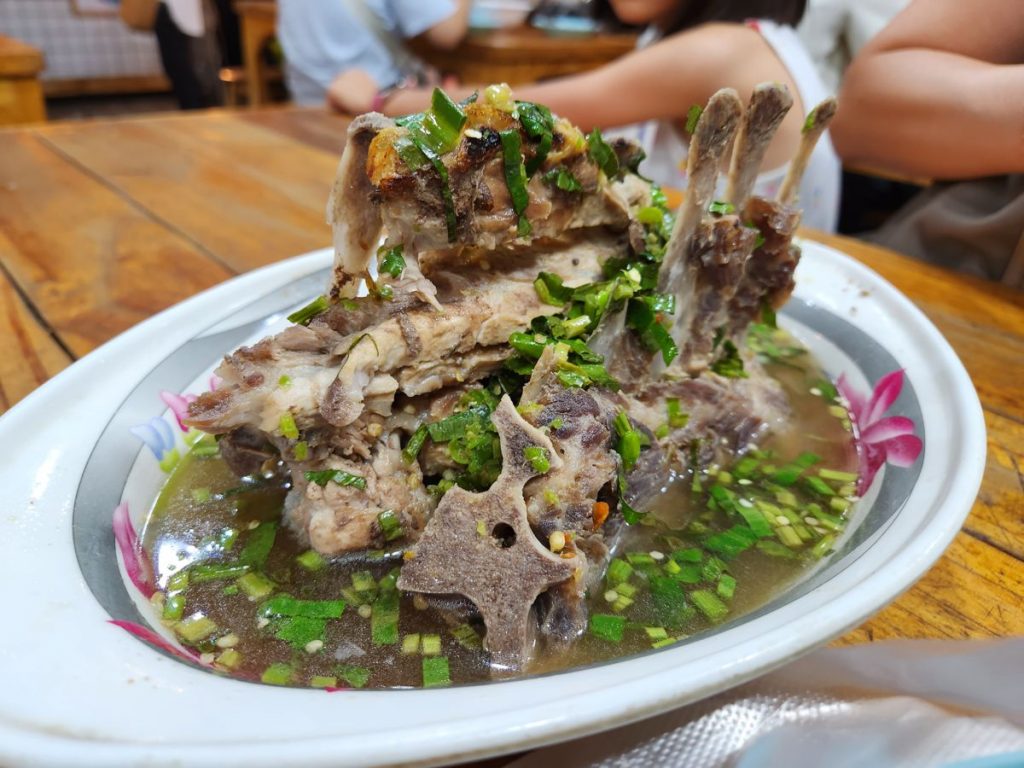
Kai Jiao (Thai Omelette)
I had little interest in omelettes or anything super deep fried, but this was a staple in Thai cuisine and a vocab in my food words 101 lesson, so we gave it a shot when the opportunity conveniently presented itself. Not sure how many eggs or how many cups of oil were involved, but this Kai Jiao was larger than my face. Similar to Kai Dao which was a version of sunny side up, Thai cooking seemed to deep fry eggs like nobody else. The first couple bites were fairly enjoyable but then the grease set in.
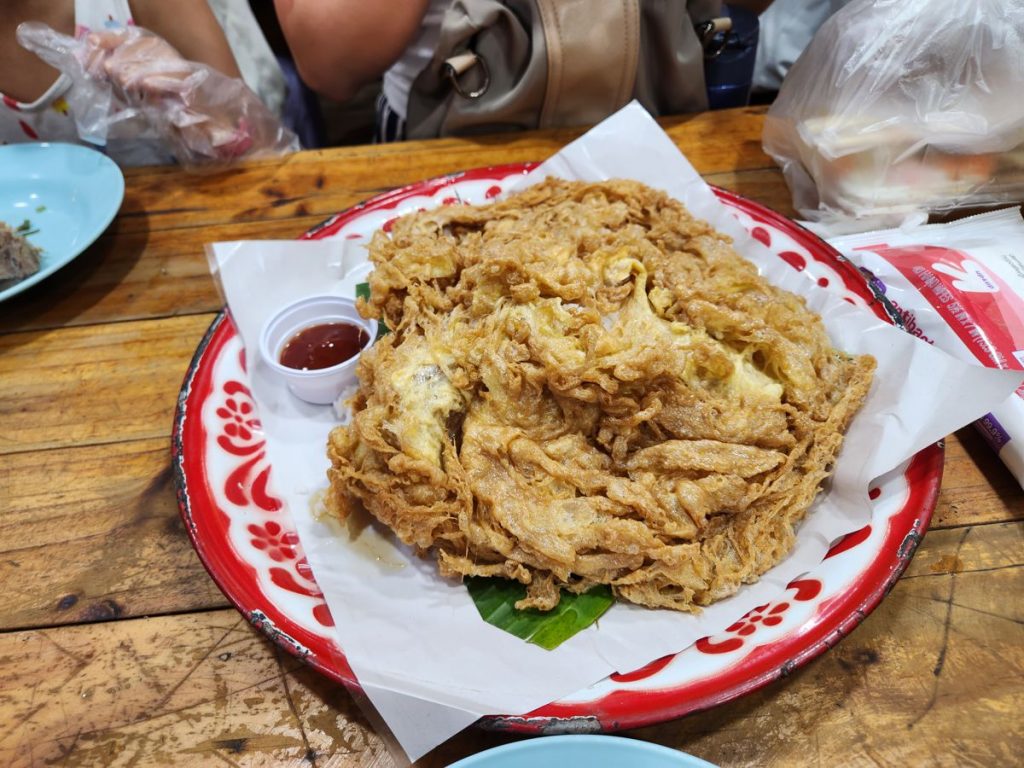
Pla Pao (Grilled Fish)
Whole grilled fish was among the most commonly seen foods in Thailand. From tourist traps to traditional produce markets, there was always someone manning a grill with a few fish on it.
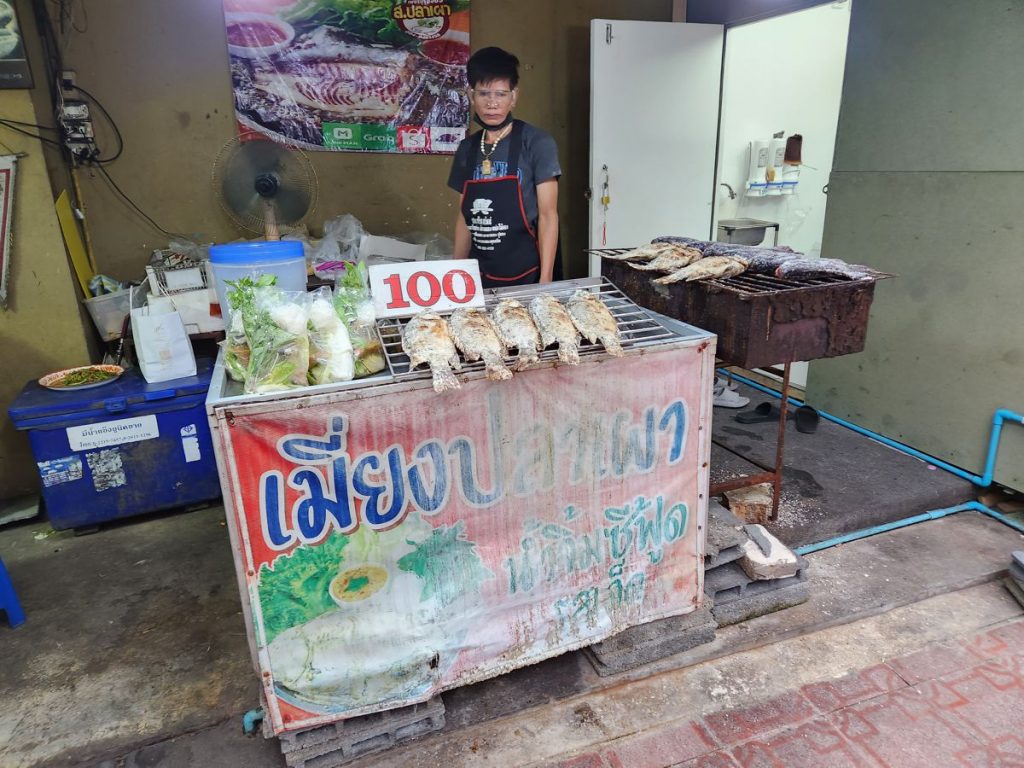
Given its classic status, Pla Pao had been on my bucket list for over six years. However, a whole fish always seemed overwhelming in a street food setting, and the salt-crusted body had such a dry appearance that I found off putting. Thus I had passed it up at every turn during the last trip and this trip. Just as we were about to leave Thailand again, I made up my mind to buy one for our final dinner.
And I was so glad to have tried it because it was among the best fish I had ever had. This sweet lady at Chiang Rai Night Bazaar cooked the fish and had her daughter deliver it across the food court to our table. The top layer of the skin had been peeled off along with the salt crust. I had wondered in hindsight if fish vendors always served it like this, or did she do it as a special favor to prevent this dumb tourist from biting into what was meant to be inedible. The flesh under the mummified skin was delicate, tender, and juicy, perhaps even more so than the average steamed fish. It had such rich flavor that the chili condiment was almost unnecessary.
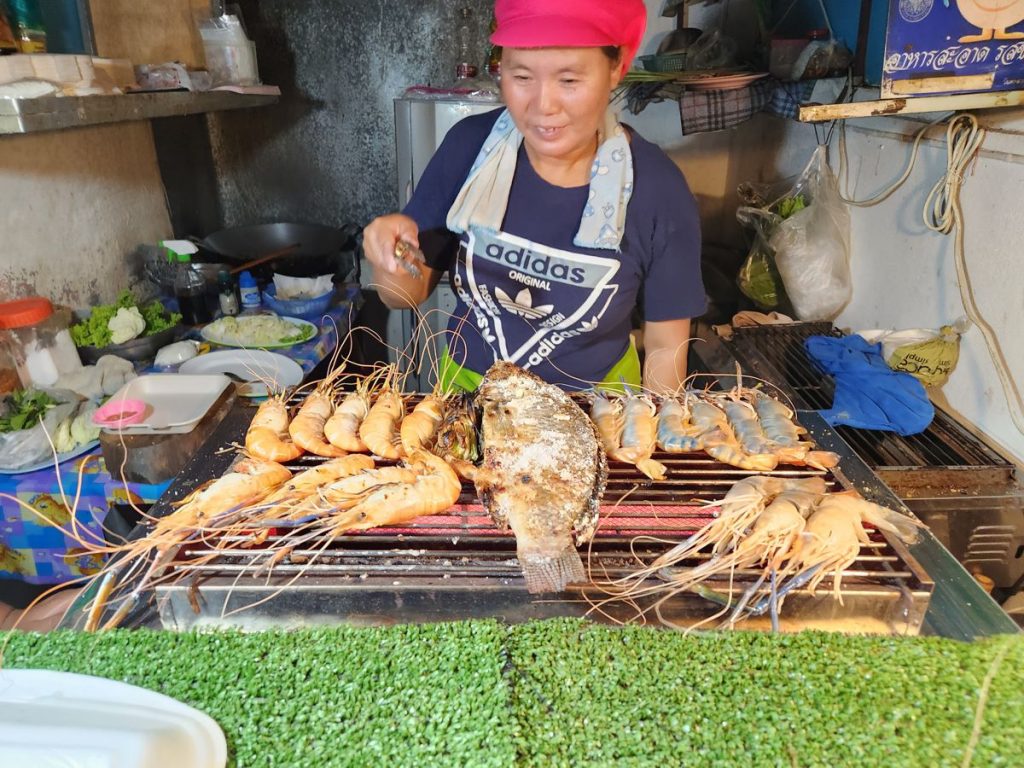
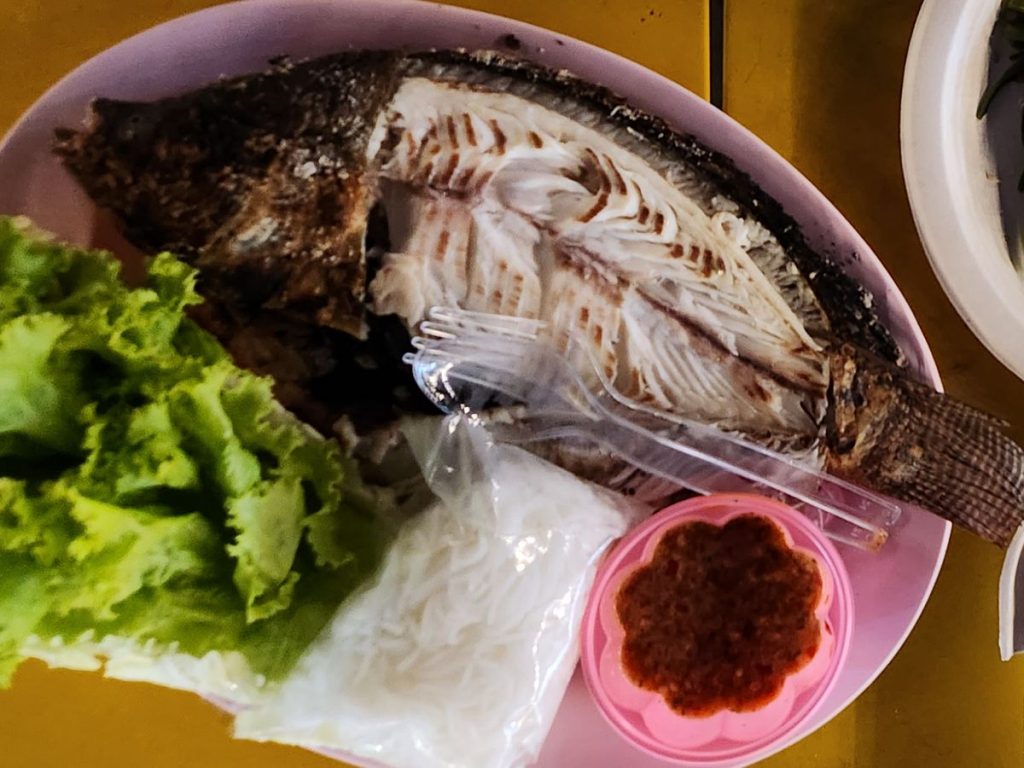
Hong asked me to compare this $3 fish to Kokkari’s $50 whole grilled fish. Price and the level of service aside, to be quite honest, I would prefer to eat this Pla Pao any day.
Pon La Mai (Fruits)
By weight, more than 50% of what I ate in Thailand were fruits. Guava, pineapple, mango, and others were so fragrant, abundantly available, and affordable. I was in heaven.
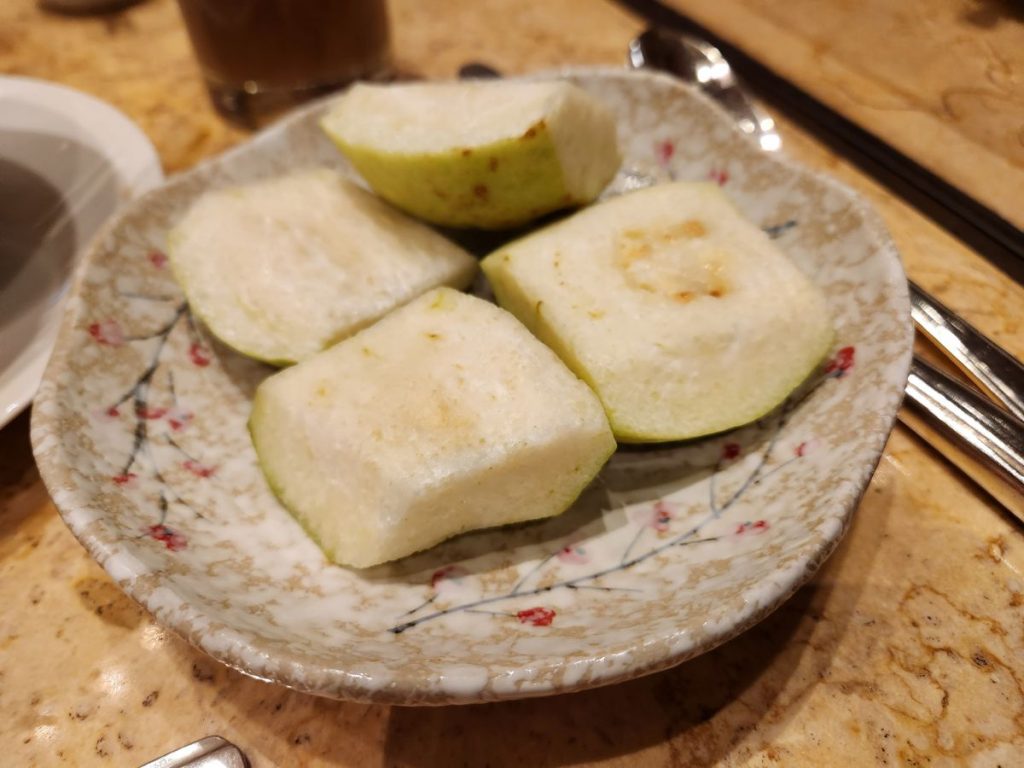
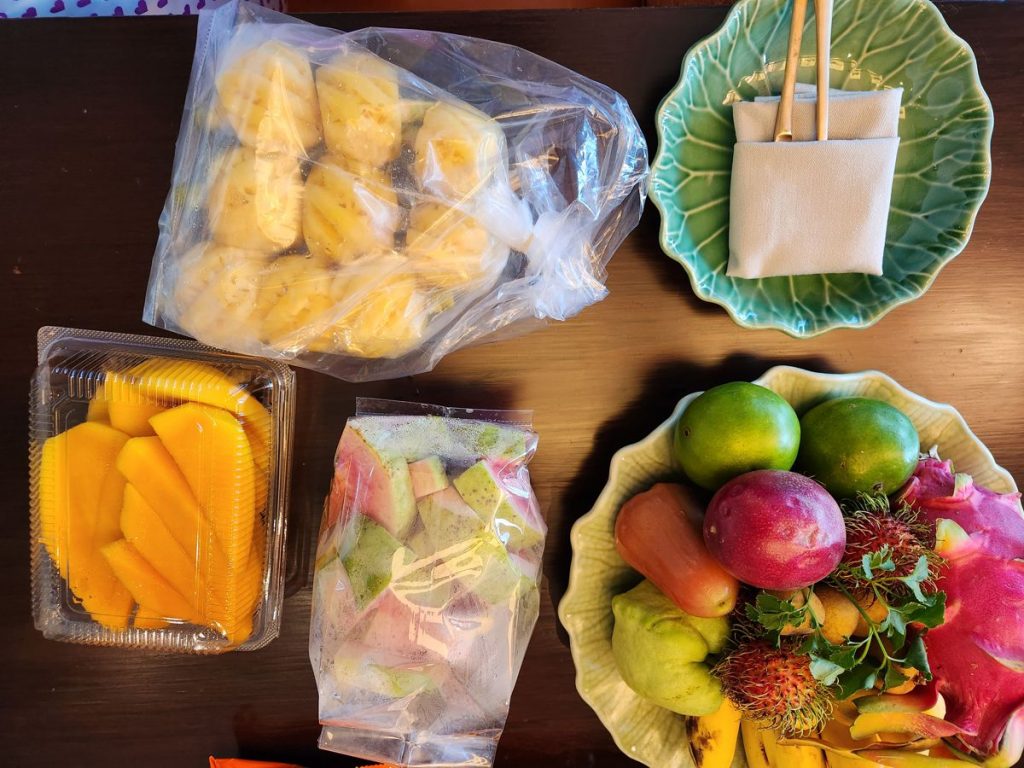
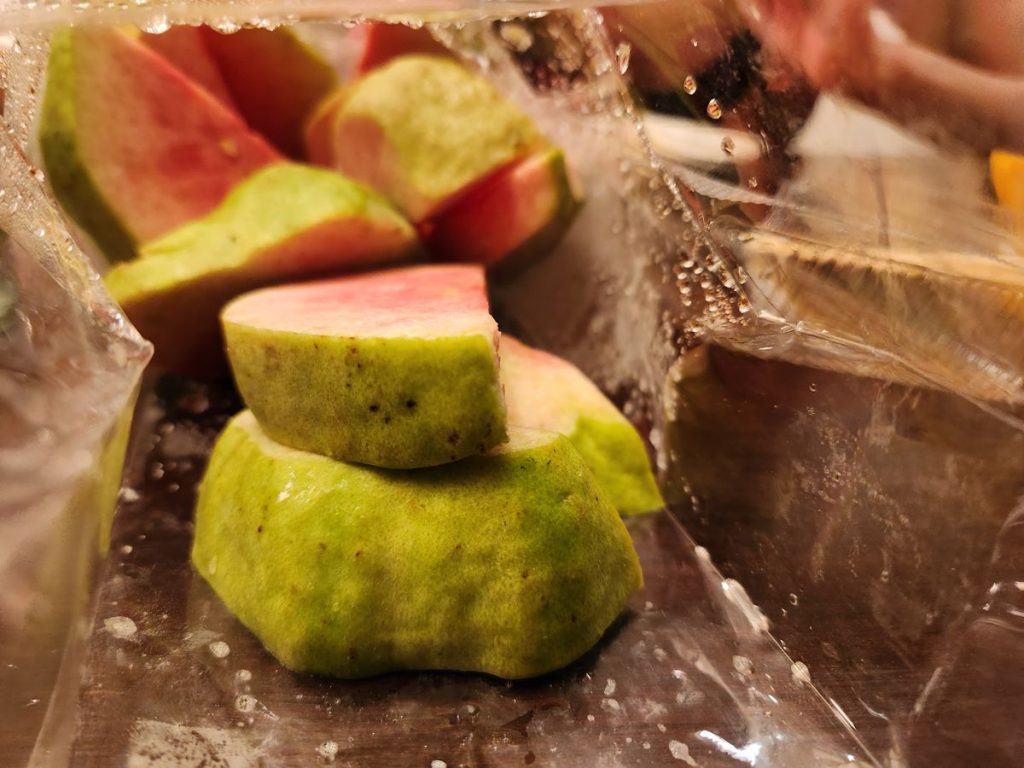
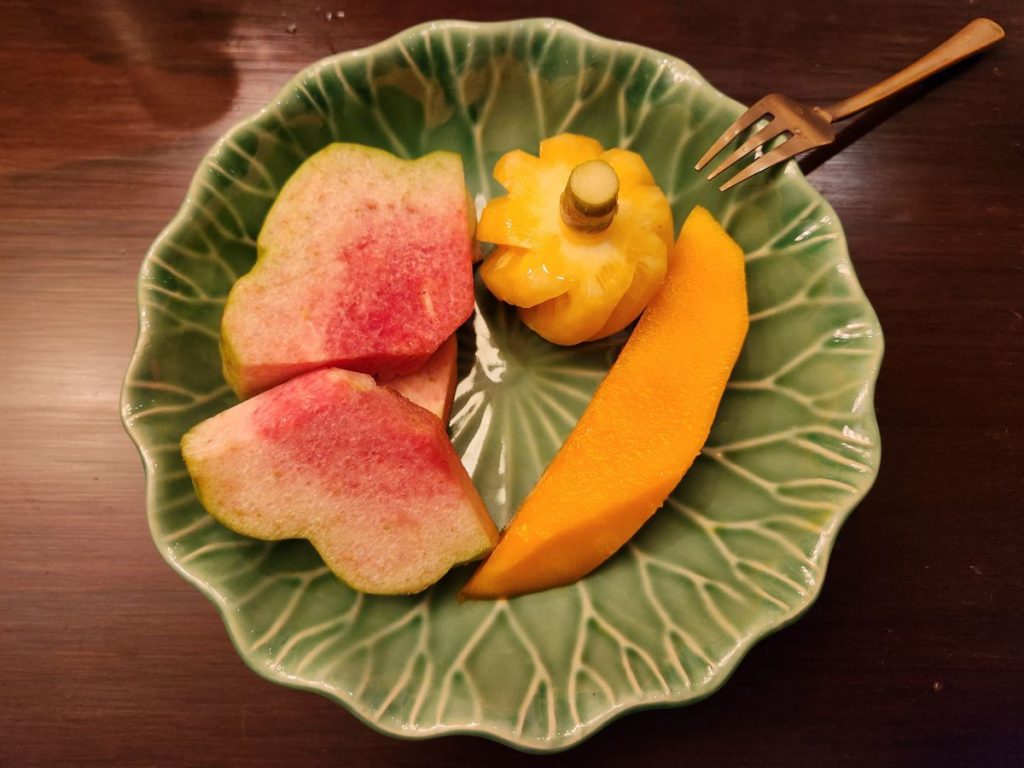
Gah-Fare (Coffee)
The cafe culture in Thailand was well known, and we used it as an excuse to justify our borderline unhealthy level of coffee consumption on this trip. Generally speaking, cafes there appeared similar to what you could find in the wealthier parts of San Francisco and New York – beautiful decorations, comfortable seating, barista speaking perfect English, and a menu of espresso-based drinks such as caffe latte and cappuccino.
What differed from America was that Thailand produced its own coffee beans. Like Pad Thai, coffee cultivation was a hugely successful cultural product manufactured by the Thai government. If we weren’t so lacking in palate to appreciate the finer flavor profiles, we might have considered visiting a coffee farm in Chiang Mai.
In addition to the iced latte that I had at least twice every day, Thai cafes often offered their own drinks that were great for the lactose intolerant… espresso cola, espresso mango, etc. I tried a coconut espresso once, but it was unfortunately too sweet.
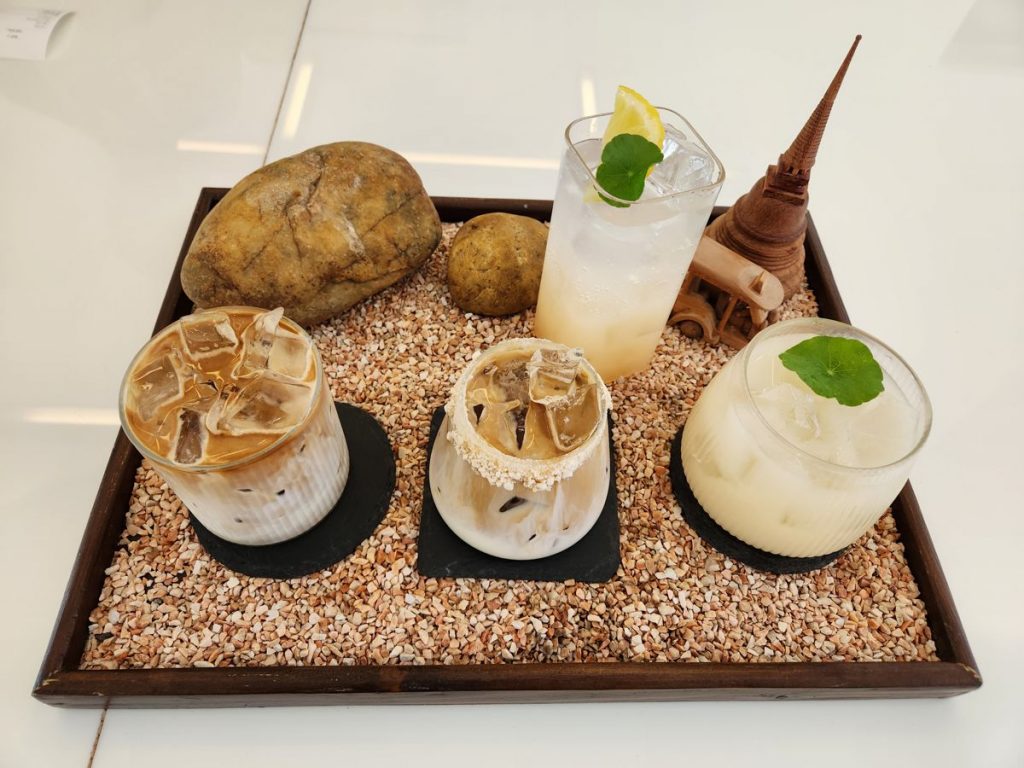
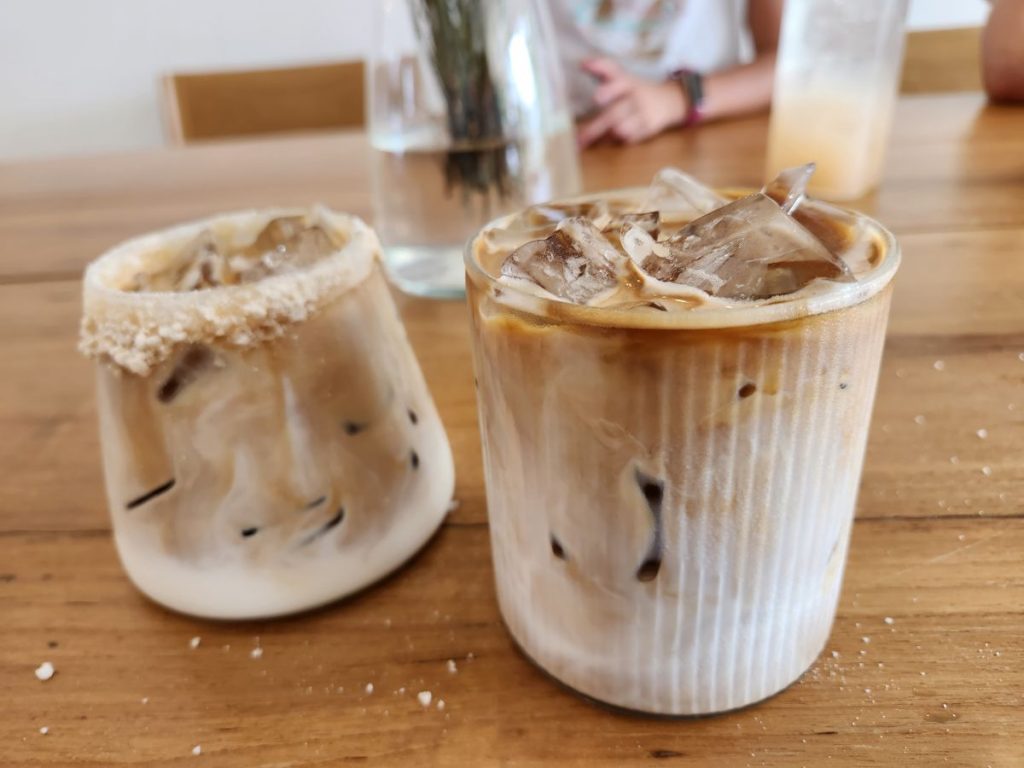
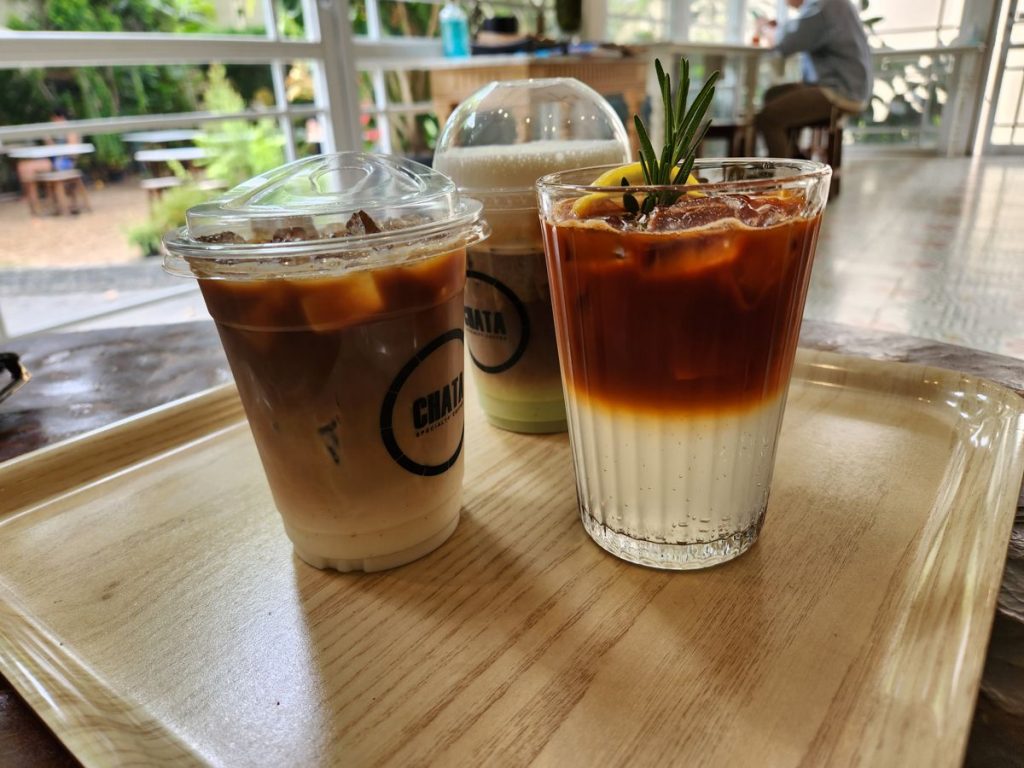
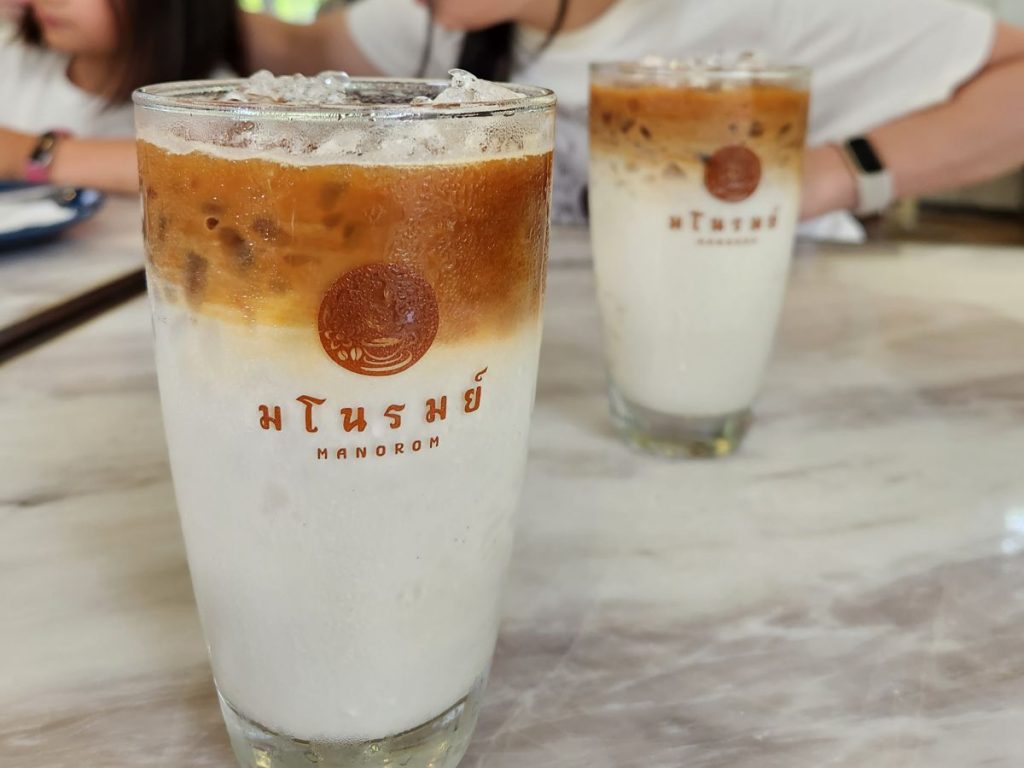
Southeast Asia 2023 – Index
- Kicking Off 15 Intensely Fun Days in Thailand and Singapore
- Attempting the Thai Language
- Modes of Transportation
- Bangkok: Grand Hyatt Erawan
- Bangkok: Itinerary 1
- Bangkok: Itinerary 2
- Bangkok: Malls
- Overnight Train to Chiang Mai
- Chiang Mai: Itinerary
- Chiang Mai: Elephants!!!
- Chiang Rai: Itinerary
- Wats in Thailand
- Notable Eats in Thailand
- Singapore: Itinerary
- Singapore: Deja Vu
- Singapore: Changi Airport & Flight Home
- Notable Eats in Singapore
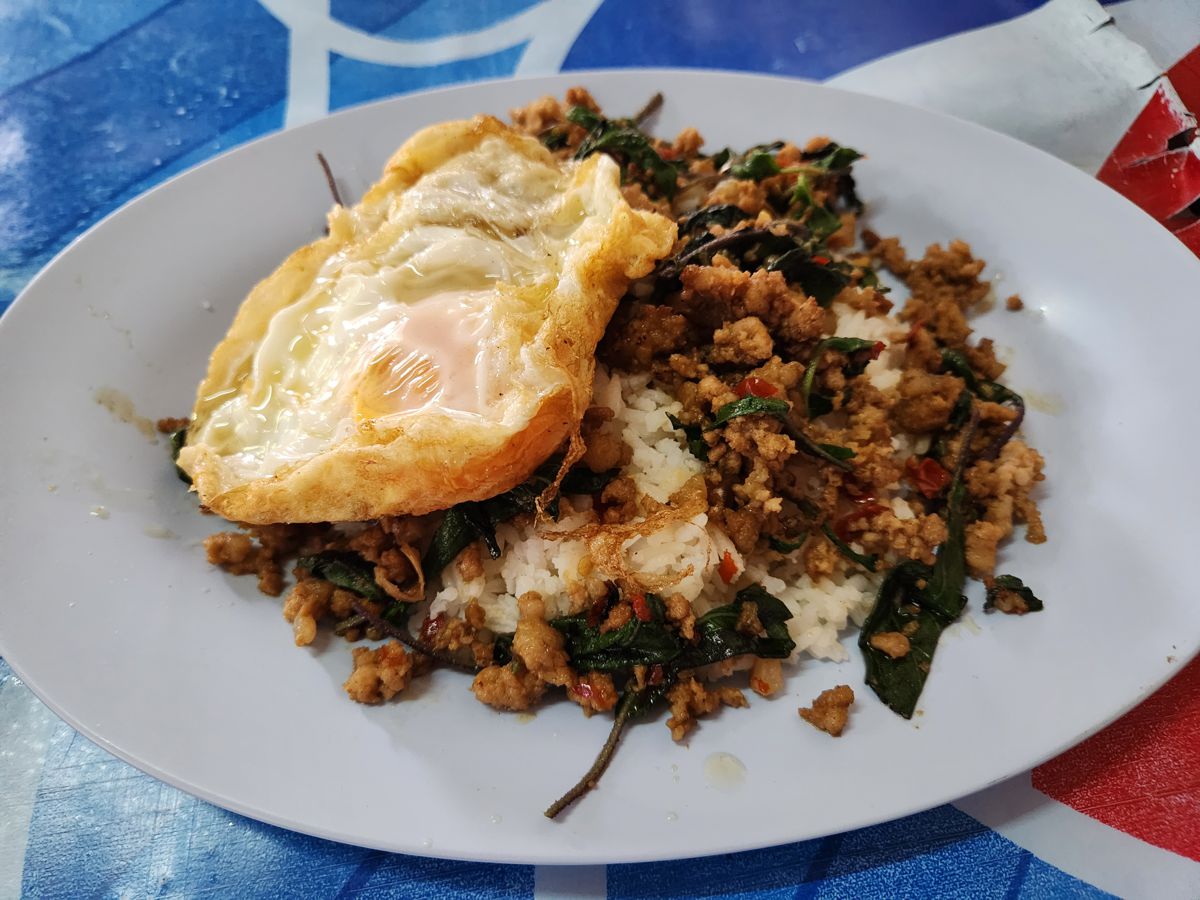
SEA 2023 (14/17) – Singapore: Itinerary – Peter's Blog
August 21, 2023 at 2:39 am[…] Notable Eats in Thailand […]
SEA 2023 (16/17) – Singapore: Changi Airport & Flight Home – Peter's Blog
August 21, 2023 at 11:58 pm[…] Notable Eats in Thailand […]
SEA 2023 (17/17) – Notable Eats in Singapore – Peter's Blog
August 22, 2023 at 1:01 am[…] Notable Eats in Thailand […]
SEA 2023 (1/17) – Kicking Off 15 Intensely Fun Days in Thailand and Singapore – Peter's Blog
August 22, 2023 at 1:04 am[…] Notable Eats in Thailand […]